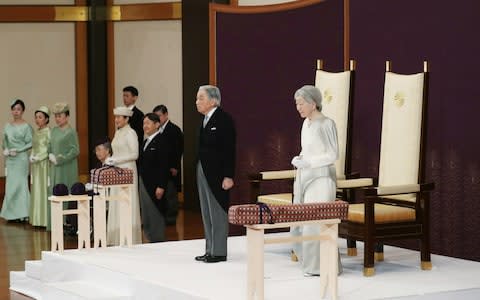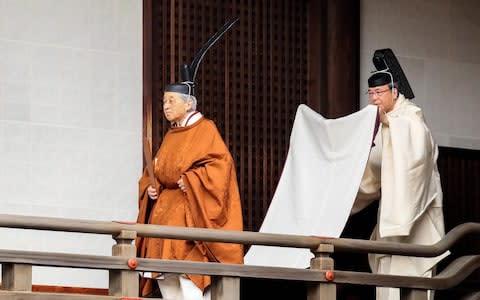Japan's Emperor Akihito abdicates in historic ceremony

Japan’s Emperor Akihito today abdicated after 30 years at the helm of the Chrysanthemum Throne, paving the way for his son to take over and heralding a new era.
On a historic day for Japan, Emperor Akihito, 85, completed the nation’s first abdication in more than 200 years during a brief ceremony in a state room of the Imperial Palace in Tokyo.
During the ten-minute ceremony at 5pm local time, Emperor Akihito addressed the nation for the last time in the Heisei era, a period spanning three peaceful decades that ends at midnight tonight.
A new era called Reiwa – meaning “beautiful harmony” will then commence and his son Crown Prince Naruhito will assume step into his position, with an ascension ceremony tomorrow morning.
The emperor, dressed in formal black tailcoat and a grey tie, was accompanied by his wife Empress Michiko in a long white silk dress and white gloves, as he made his way into the Matsu no Ma “Pine Hall” for the abdication ceremony.
In his final speech as emperor, while flanked by hinoki cypress wood stands carrying the Imperial Regalia and Privy and State Seals, he said: “Since ascending the throne 30 years ago, I have performed my duties as the emperor with a deep sense of trust in and respect for the people, and I consider myself most fortunate to have been able to do so.
“I sincerely thank the people who accepted and supported me in my role as the symbol of the state. I sincerely wish, together with the empress, that the Reiwa Era, which begins tomorrow, will be a stable and fruitful one, and I pray, with all my heart, for peace and happiness for all the people in Japan and around the world.”
The abdication ceremony was attended by nearly 300 guests, including senior members of the Imperial family, heads of both chambers of parliament, chief justices of the supreme court and local government leaders.
As brief as it was historic, it was the culmination of years of planning, with the emperor last month commencing a string of more complex Shinto prayers, rituals and offerings for his abdication at key sites across the country.
Today’s final abdication proceedings began shortly after 10am, when the emperor, dressed in traditional dark orange robes and a black headdress, walked slowly into an Imperial Palace sanctuary to inform Amaterasu, the mythical sun goddess and ancestress of all emperors, of his plans to abdicate.
He went on to perform ceremonies at two other key shrines in the Imperial Palace, followed by his son and heir Crown Prince Naruhito, who also worshipped at the three sanctuaries, ahead of his accession.
His distinct traditional attire, including an unusually tall headdress, is known as Korozen no Goho, an imperial outfit that dates back to the 9th century and is worn only by the emperor when performing important rituals.

Despite drizzly weather on and off throughout the day, crowds of Japanese and foreign tourists gathered near the Imperial Palace in central Tokyo, where several thousand police personnel had reportedly been deployed amid heightened security.
Among them was Kimiyo Miyagawa, 68, a housewife from northern Japan who had travelled to the palace with her daughter to pay tribute to the outgoing emperor.
“I wanted to come to the Imperial Palace as they (emperor and empress) are like the father and mother of the country,” she said.
“I would like to tell them ‘Thank you so much for your hard work’. I’m full of gratitude.”
At midnight on Tuesday, Emperor Akihito and Empress Michiko will cease their roles, making way for Crown Prince Naruhito and his wife Crown Princess Mashiko to take their place at the helm, as the new Reiwa era commences.
On Wednesday morning, a special accession ceremony known as Kenji-to-Shokei-no-gi will take place, enabling the incoming emperor to inherit the Imperial Regalia – a sacred trinity consisting of a sword, a mirror and a gem – to confirm his sovereignty.

The festivities will not end here, however, with the new emperor’s Enthronement Ceremony due to take place in October, attended by dignitaries from nearly 200 countries.
It was in 2016 that Emperor Akihito, who previously underwent treatment for prostate cancer and heart surgery, expressed his wish to abdicate in a televised message in which he cited concerns about fulfilling his duties due to his advancing age.
He was the first emperor to be enthroned under the nation’s pacifist post-war constitution and took painstaking steps to carve out his official role as “symbol of the state”.
During Emperor Akihito’s tenure, he emerged as a symbol of reconciliation, repeatedly seeking to make amends for the Second World War as he travelled overseas as a neutral figurehead of Japan on dozens of visits.

